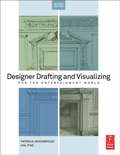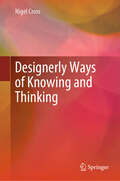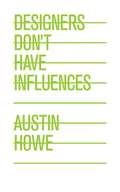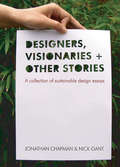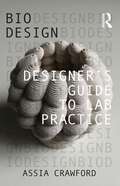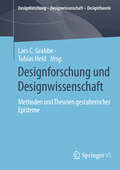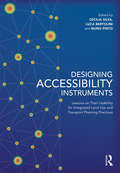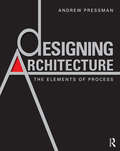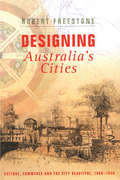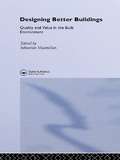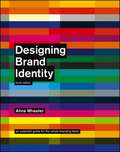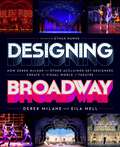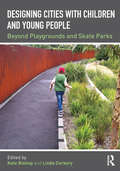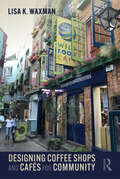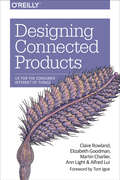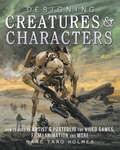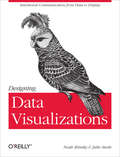- Table View
- List View
Designer Drafting And Visualizing For The Entertainment World
by Patricia Woodbridge Hal TineIn the second edition of Designer Drafting and Visualization for the Entertainment World, Patricia Woodbridge, a highly experienced art director of feature films and a long time teacher of scenic drafting and set design at the graduate level teams up with nationally-renowned scenic designer and SCAD professor Hal Tine to give you a dynamic glimpse into the world of designing for mainstream entertainment including theatre, film, tv, and corporate events. Drawing on designs from real Hollywood and Broadway blockbusters, this book provides you with the basic tools and principles of scenic drafting and rendering, beginning with pencil drafting and culminating with the latest information on CAD drafting, digital 3D modelling, digital and hand/digital rendering, and digital graphics for sets. Full of examples from all areas of entertainment, this book not only builds on basic principles of designer drafting to give you the most comprehensive knowledge on the subject, but also illuminates scenic career paths with insights from professional set design artists who discuss their education and varied career progressions.
Designer Knit Home: 24 Room-By-Room Coordinated Knits to Create a Look You'll Love to Live In
by Erin Eileen BlackSurround yourself with beautiful knits in every room in your house! Patterns are styled and grouped by room to create a unified look for your Living Room, Porch, Master Bedroom, Guest Bedroom, Office, Kid's Bedroom, and Nursery. All pieces are knit with big needles and easy-to-learn stitch patterns, so you can be enjoying your knits in no time. Every room has at least one textured chunky blanket for comfort; other patterns include cushion covers, pillows, baskets and others, all in coordinating stitch/style and colors. The sumptuous knits are shown styled in a modern, neutral palette that works well in any decor, but if your style is more colorful, the patterns are classics that will work in any color scheme you choose.
Designerly Ways of Knowing and Thinking
by Nigel CrossThis book is an edited collection of key lectures and foundational publications by Professor Nigel Cross on creative design thinking. This is an expanded and updated new edition of the previous version, with three additional chapters. The book investigates and explains the nature of designerly ways of knowing and thinking, and offers rich insights into a field of study that provides important foundations for design education, research and practice. The view that designers have and use particular designerly ways of knowing and thinking developed from new approaches in design education and new empirical studies of design processes. The concept was first clearly articulated by Professor Cross, one of the most respected design researchers internationally. Since then, the field of study has grown considerably, as both design education and design research have developed together into a practice-based discipline influential across many spheres of design and innovation. As an extensive review of scholarship and research, and a resource for studying designerly ways of knowing and thinking, the book will be of value to researchers, teachers, students and practitioners across all fields of design, including engineering and architectural design, industrial and product design, software and service design. It will also be of interest to those engaging in creative developments across a wide range of social and technological innovation.
Designers Don't Have Influences
by Austin HoweFeeling uninspired? If you're a creative professional-or just someone who'd like to be more creative in your work and daily life-look no further than Designers Don't Have Influences. Creative director, writer, advocate, and design cheerleader Austin Howe's elegant, incisive, and amusing essays are sure to appeal to a wide spectrum of readers. Howe chronicles the lives, philosophies, and work processes of leaders in disparate fields from art to spirituality and even ice hockey, many of whom have never before been profiled in print. Howe explores the creative process and conceptualization, delving into what to do when creativity is lacking. Graphic designers, industrial designers, architects, artists, advertising people, businesspeople, students, and anyone seeking inspiration will appreciate this much-anticipated sequel to Designers Don't Read, returning to it again and again for sparks of on-demand inspiration and innovation.
Designers Don't Read
by Austin Howe Fredrik AverinAustin Howe is a creative director, writer, advocate, and cheerleader for design-but not a designer. He believes "in the wonder and exuberance of someone who gets paid-by clients to do what he loves." Howe places immense value on curiosity and passion to help designers develop a point of view, a strong voice. He explores the creative process and conceptualization, and delves into what to do when inspiration is lacking. If there's a villain in these elegant, incisive, amusing, and inspiring essays, it's ad agencies and marketing directors, but even villains serve a purpose and illustrate the strength of graphic design "as a system, as a way of thinking, as almost a life style." Howe believes that advertising and design must merge, but merge with design in the leadership role. He says that designers should create for clients and not in the hope of winning awards. He believes designers should swear "a 10-year commitment to make everything we do for every client a gift." If this sounds like the designer is the client's factotum, not so. Howe also argues in favor of offering clients a single solution and being willing to defend a great design. Organized not only by topic, but also by how long it will take the average reader to complete each chapter, Designers Don't Read is intended to function like a "daily devotional" for designers and busy professionals involved in branded communications at all levels. Begun as a series of weekly essays sent every Monday morning to top graphic designers, Designers Don't Read quickly developed a passionate and widespread following. With the approximate time each chapter might take to read, Designers Don't Read's delight and provocation can be fit into the niches in the life of a time-challenged designer. Or it may be hard to resist reading the entire book in one sitting!
Designers Visionaries and Other Stories: A Collection of Sustainable Design Essays
by Jonathan ChapmanDesigners, Visionaries and Other Stories unpacks the complex and crucial debates surrounding sustainable design to deliver a compelling manifesto for change, at a time of looming ecological crisis, mounting environmental legislation and limited progress. This is a book about sustainable design, by the leading sustainable design thinkers, for creative practitioners, professionals, students and academics. This challenging work provides the reader with a rich resource of future visions, critical propositions, creative ideas and design strategies for working towards a sustainable tomorrow, today. The authors boldly present alternative understandings of sustainable design, to curate a challenging, sometimes uncomfortable and always provocative, collection of essays by some of the worlds leading sustainable design thinkers. The result is an impacting and polemical anthology that reinvigorates the culture of critique that, in previous years, has empowered design with the qualities of social, environmental and economic revolution.
Designers' Shakespeare
by John Russell Brown Stephen Di BenedettoTheatre Design involves everything seen on stage: not only scenery but costumes, wigs, makeup, properties, lighting, sound, even the shape and material of the stage itself. Designers’ Shakespeare presents and analyses the work of a half-dozen leading practitioners of this specialist art. By focusing specifically on their Shakespearean work, it also offers a fresh, exciting perspective on some of the best-known drama of all time. Shakespeare’s plays offer an unusual range of opportunities to designers. As they were written for a theatre which gave no opportunity for scenic support or embellishment, designers are freed from any compulsion to imitate original practices. This has resulted in the extraordinarily diverse range of works presented in this volume, which considers among others the work of Josef Svoboda, Karl-Ernst Herrmann, Ming Cho Lee, Alison Chitty, Robert Wilson, Societas Raffaello Sanzio, Filter Theatre, Catherine Zuber, John Bury , Christopher Morley, Ralph Koltai and Sean Kenny. Designers’ Shakespeare joins Actors’ Shakespeare and Directors’ Shakespeare as essential reading for lovers of Shakespeare from theatre-goers and students to directors and theatre designers.
Designer’s Guide to Lab Practice (Bio Design)
by Assia CrawfordThis book explores the growing field of bio-design through interdisciplinary creative practice. The volume illustrates a range of experimental working techniques while offering a foundational understanding of lab practice principles. The book highlights the myriad of opportunities presented by microorganisms that have reshaped the planet and made it habitable. The book provides an account of the creation of living materials from the point of view of an architectural design practitioner. The transition from traditional design practice to laboratory investigation is captured, highlighting strategies of creating partnerships across a range of fields. The book demonstrates laboratory methods and ways of investigating the development of living materials and celebrates the growing body of practitioners, scientists, activists and anthropologists who are reimagining new strategies for addressing contemporary environmental challenges. Designer's Guide to Lab Practice looks at ways in which integrating living components with needs of their own would not only help offset the environmental impact that we have on our planet but could also create a closer relationship with nature. It is a working manual as well as a guide to emerging practitioners seeking to transition into a field that is yet to be defined and that offers the promise of a new era of human habitat making as a direct response to the looming ecological crisis.
Designforschung und Designwissenschaft: Methoden und Theorien gestalterischer Episteme (Designforschung – Designwissenschaft - Designtheorie)
by Tobias Held Lars C. GrabbeVon Gestaltung jenseits ästhetischer Traditionslinien zu sprechen, heißt zwangsläufig das moderne Design in den Blick zu nehmen. Zwischen Alltagskultur und Design-Avantgarden bewegen sich vielfältige interdisziplinäre Strömungen, deren theoretische Modelle in Kontextualisierungen und Analysen der Designwissenschaft zusammenlaufen. Hier zeigt sich bereits eine geisteswissenschaftliche Durchdringung und Akzeptanz des Designs als epidemisches Gegenstück zur freien Kunst, wobei diese Meta-Perspektive letztlich eine Forschung „über Design“ darstellt. Design als konkrete Praxis begriffen artikuliert sich jedoch als Relation von Problem, Entwurf und Prototyp, so dass ein handlungstheoretisches Modell einer Forschung „durch Design“ angesetzt werden kann. Designforschung steht damit im Kontrast zur Designwissenschaft, denn sie agiert dynamisch, empirisch und operativ und bündelt zwar Theoriemodelle und konkrete Werkzeuge, lässt diese aber innerhalb konkreter Gestaltungsweisen zu pragmatischen Erkenntnissen werden. Der Band adressiert konkrete Designfelder, arbeitet Aspekte der konkreten und empirischen Designforschung heraus und nimmt gleichzeitig eine Verortung innerhalb der medientheoretischen Bezugsfelder vor. Denn Forschung „durch Design“ geschieht immer durch Medien, Werke, Instrumente und ästhetische Zeichen und Zustände hindurch.
Designing Accessibility Instruments: Lessons on Their Usability for Integrated Land Use and Transport Planning Practices
by Luca Bertolini Cecilia Silva Nuno PintoThe integration of land use and transport planning is key to making cities sustainable and liveable. Accessibility can provide an effective framework for this integration. However, today there is a significant gap between the advances in scientific knowledge on accessibility and its effective application in planning practice. In order to close this gap, Designing Accessibility Instruments introduces a novel methodology for the joint assessment and development of accessibility instruments by researchers and practitioners. The book: provides a theoretical and professional analysis of the main concepts behind the definition, use and measurement of accessibility; undertakes a comprehensive inventory and critical analysis of accessibility instruments, focusing on the bottlenecks in their transposition to planning practice; introduces and applies a novel methodology for the assessment and improvement of the practical use and usefulness of accessibility instruments; presents six in-depth illustrative case study applications of the methodology, representing a range of cities with different geographical and institutional settings, and different levels of urban and transport planning integration. The book is supported by a companion website – www.accessibilityplanning.eu – which extrapolates its content to a broader scope and keeps it updated and valid with new iterations of the methodology and further advances on the initial and new case studies.
Designing Architecture: The Elements of Process
by Andrew PressmanDesigning Architecture is an indispensable tool to assist both students and young architects in formulating an idea, transforming it into a building, and making effective design decisions. This book promotes integrative and critical thinking in the preliminary design of buildings to inspire creativity, innovation, and design excellence. This compendium of individual wisdom and collective experience offers explicit guidance to students and young professionals on how to approach, analyze, and execute specific tasks; develop and refine a process to facilitate the best possible design projects; and create meaningful architectural form. Here the design process – from orchestrating client participation to finalizing schematic design – is explored and illuminated. The following material is presented to make the book a useful didactic tool for professional development: explicit strategies for doing design rather than simply reviewing principles and precedents creative ideas in approaching and framing problems in design terms specific methods to translate ideas to culturally significant, socially responsive, and environmentally sensitive buildings techniques to integrate all levels of cognition from analysis to epiphany counsel on developing a personalized process for engaging design projects case studies augment the text and chronicle fascinating applications of the design process. The essence of this book lies in an integrated and holistic approach to each unique project as well as fostering curiosity and exploration – a departure from algorithms, easy generalities, or a formula for design. Designing Architecture will inspire readers to elevate the quality of preliminary designs and unravel some of the mystery of creating the most beautiful, responsive, and responsible architectural design possible.
Designing Aspen: The Houses of Rowland+Broughton
by John Rowland Sarah BroughtonIn this luxurious and aspirational home design book, the founders of renowned Colorado firm Rowland+Broughton share a selection of their extraordinary residential projects, with Aspen and the Rocky Mountains as the dazzling backdrop.Rowland+Broughton is known for shaping the town of Aspen with their visionary work in urban design and historic preservation. Here, founders John Rowland and Sarah Broughton showcase ten spectacular residences in Aspen and the Rocky Mountains created by their innovative and talented firm.With beautiful photography throughout, Designing Aspen includes a range of houses, from Mountain Retreat, a modern lodge-style home located at the base of Aspen Highlands, to Meadow House, positioned at the edge of a meadow amid an existing forest of spruce and evergreens, and from Art Barn, a residence with the specific purpose of displaying art, to Bagua, a Zen mountain retreat. Also featured are essays about Aspen and its history and relevance; the importance of historic preservation; client relationships; and the philosophy of the firm; and a foreword by Tom Kundig. Perfect for lovers of home design and architecture, anyone who aspires to build or decorate a house in the mountains, and visitors and residents of Aspen enthralled by its charms, this makes a beautiful coffee table book and a captivating volume of residential design expertise and inspiration.
Designing Australia's Cities: Culture, Commerce and the City Beautiful, 1900�1930 (Planning, History And Environment Ser.)
by Robert FreestoneAccessible and comprehensive, written by the current President of the International Planning History Society, this volume provides readers with a highly visual account of historical, contemporary and international projects.Looking at the ways in which the City Beautiful movement influenced the design and development of Australian cities, this pioneering national study surveys the ruling ideas, influences, outcomes and enduring legacies of the early artistic turn in Australian urban design. With the return of the American City Beautiful movement to the forefront of urban design, Designing Australia’s Cities is a relevant account of the ways in which this movement influenced and shaped Australian city design, but more importantly sheds light on a planning culture that stretches far beyond Australia and is of increasing relevance worldwide today.Laying bare an important design and reform movement, whose under-appreciated legacy is clearly evident in urban landscapes today, this book is ideal for students of planning, architecture, urban design and the history of planning.
Designing Better Building: Quality And Value In The Built Environment
by Sebastian MacmillanDesign is widely recognised as the key to improving the quality of the built environment. This well-illustrated book comprises 15 chapters written by leading practitioners, clients, academics and other experts, and presents the latest thinking on what design quality is and how to achieve it. For design practitioners and their clients alike, the book provides evidence to justify greater focus on, and investment in, design. It summarises the benefits that arise from good design - such as, civic pride in the urban environment, the stimulation of urban regeneration, corporate identity, occupant productivity and health in offices, improved learning outcomes in schools, better patient recovery rates in hospitals, as well as reduced environmental impact. And it illustrates these benefits through case study examples. Eight chapters focus on case studies of exemplary buildings in particular sectors - offices, schools, housing, and hospitals - and explain why and how they came to be designed, and the design qualities they exhibit.
Designing Brand Identity: An Essential Guide for the Whole Branding Team
by Alina Wheeler<p>A revised new edition of the bestselling toolkit for creating, building, and maintaining a strong brand <p>From research and analysis through brand strategy, design development through application design, and identity standards through launch and governance, Designing Brand Identity, Fourth Edition offers brand managers, marketers, and designers a proven, universal five-phase process for creating and implementing effective brand identity. Enriched by new case studies showcasing successful world-class brands, this Fourth Edition brings readers up to date with a detailed look at the latest trends in branding, including social networks, mobile devices, global markets, apps, video, and virtual brands.</p>
Designing Broadway: How Derek McLane and Other Acclaimed Set Designers Create the Visual World of Theatre
by Eila Mell Derek McLaneIn this richly illustrated and information-packed celebration of Broadway set design, Tony Award–winning designer Derek McLane explores the craft while reflecting on some of the greatest stage productions of the past few decades.Together with other leading set design and theatre talents, McLane invites us into the immersive and exhilarating experience of building the striking visual worlds that have brought so many of our favorite stories to life. Discover how designers generate innovative ideas, research period and place, solve staging challenges, and collaborate with directors, projectionists, costume designers, and other artists to capture the essence of a show in powerful scenic design.With co-writer Eila Mell, McLane and contributors discuss Moulin Rouge!, Hamilton, Hadestown, Beautiful, and many more of the most iconic productions of our generation. Among the Broadway luminaries who contribute are John Lee Beatty, Danny Burstein, Cameron Crowe, Ethan Hawke, Moisés Kaufman, Carole King, Kenny Leon, Santo Loquasto, Kathleen Marshall, Lynn Nottage, David Rabe, Ruben Santiago-Hudson, Wallace Shawn, John Leguizamo, and Robin Wagner.Filled with personal sketches and photographs fromthe artists&’ archives, this stunningly designed book is truly a behind-the-scenes journey that theatre fans will love.
Designing Cities with Children and Young People: Beyond Playgrounds and Skate Parks
by Kate Bishop and Linda CorkeryDesigning Cities with Children and Young People focuses on promoting better outcomes in the built environment for children and young people in cities across the world. This book presents the experience of practitioners and researchers who actively advocate for and participate with children and youth in planning and designing urban environments. It aims to cultivate champions for children and young people among urban development professionals, to ensure that their rights and needs are fully acknowledged and accommodated. With international and interdisciplinary contributors, this book sets out to build bridges and provide resources for policy makers, social planners, design practitioners and students. The content moves from how we conceptualize children in the built environment, what we have discovered through research, how we frame the task and legislate for it, and how we design for and with children. Designing Cities with Children and Young People ultimately aims to bring about change to planning and design policies and practice for the benefit of children and young people in cities everywhere.
Designing Coffee Shops and Cafés for Community
by Lisa K. WaxmanDesigning Coffee Shops and Cafés for Community brings together research, theory, and practical applications for designing coffee shops and cafes as places to enhance community connections. As people search for meaning and connection in their lives, they often seek out places that root them in their community. Designers are responsible for creating these spaces, and to do so well, they need to understand the physical and social attributes that make such spaces successful. Addressing societal trends, environment and behavior theories, place attachment, branding, authenticity, location, layout, and ambiance, the book provides guidelines to help designers and operators create more welcoming third places—places that are not home, not work, but those where we can relax in the company of others. It includes eight case studies by authors from threecountries that ground the theories in real-life third places. Its practical design guidelines cover location, accessibility, seating, lighting, sound, and more. Written for students, academics, and designers, this book discusses the value of coffee shops and cafés and guides readers through the ways to create places of belonging that bring people together.
Designing Commercial Interiors
by Christine M. Piotrowski Elizabeth A. Rogers IIDAThe definitive reference on designing commercial interiors-expanded and updated for today's facilitiesFollowing the success of the ASID/Polsky Prize Honorable Mention in 1999, authors Christine Piotrowski and Elizabeth Rogers have extensively revised this guide to planning and designing commercial interiors to help professionals and design students successfully address today's trends and project requirements. This comprehensive reference covers the practical and aesthetic issues that distinguish commercial interiors. There is new information on sustainable design, security, and accessibility-three areas of increased emphasis in modern interiors.An introductory chapter provides an overview of commercial interior design and the challenges and rewards of working in the field, and stresses the importance of understanding the basic purpose and functions of the client's business as a prerequisite to designing interiors. This guide also gives the reader a head start with eight self-contained chapters that provide comprehensive coverage of interior design for specific types of commercial facilities, ranging from offices to food and beverage facilities, and from retail stores to health care facilities. Each chapter is complete with a historical overview, types of facilities, planning and interior design elements, design applications, a summary, references, and Web sites. New design applications covered include spas in hotels, bed and breakfast inns, coffee shops, gift stores and salons, courthouses and courtrooms, and golf clubhouses.In keeping with the times, there are new chapters focusing on senior living facilities and on restoration and adaptive use. A chapter on project management has been revised and includes everything from proposals and contracts to scheduling and documentation. Throughout the book, design application discussions, illustrations, and photographs help both professionals and students solve problems and envision and implement distinctive designs for commercial interiors.With information on licensing, codes, and regulations, along with more than 150 photographs and illustrations, this combined resource and instant reference is a must-have for commercial interior design professionals, students, and those studying for the NCIDQ licensing exam.Companion Web site: www.wiley.com/go/commercialinteriors
Designing Commercial Interiors
by Christine M. PiotrowskiA practical, comprehensive resource for commercial interior design Designing Commercial Interiors is the industry standard reference, now fully revised and expanded to reflect the latest developments in commercial interior design. This book guides you through the entire design process, from planning to execution, to teach you the vital considerations that will make your project a success. This new third edition includes new: Sustainability concepts for a variety of commercial spaces Coverage of accessibility, security, safety, and codes--and how these factors influence commercial design Chapters on design research, project process, and project management Drawings and photographs of design applications Supplemental instructor's resources Commercial interior design entails a much more complex set of design factors than residential design, and many of these considerations are matters of safety and law. This book walks you through the process to give you a solid understanding of the myriad factors in play throughout any commercial project, including how the global marketplace shapes designers' business activities. Whether it's a restaurant, office, lodging, retail, healthcare, or other facility, the interior designer's job is much more complicated when the project is commercial. Designing Commercial Interiors is an exhaustive collection of commercial design skills, methods, and critical factors for professionals, instructors, and those preparing for the NCIDQ exam.
Designing Commercial Interiors
by Christine M. PiotrowskiPractical, comprehensive resource for commercial interior design, covering research, execution, safety, sustainability, and legal considerations Designing Commercial Interiors explores the entire design process of commercial projects from planning to execution to teach the vital considerations that will make each project a success. This book delivers a solid understanding of the myriad factors in play throughout designing restaurants, offices, lodging, retail and healthcare facilities. Updates to the newly revised Fourth Edition include changes to office space design to promote flexibility, post-pandemic considerations for work and interior design, the latest industry certification requirements, sustainable design considerations. and safety/legal codes. Updated supplemental instructor’s resources, including a revised instructor’s manual with sample test questions and exercises are available on the companion website. A list of terms fundamental to each chapter has also been added at the end of each chapter. Other topics covered in Designing Commercial Interiors include: A thorough review of relevant design and research skills and methods How the global marketplace shapes designers’ business activities Product specification principles, WELL, and LEED certification and credentials Accessible design in facilities, elements of evidence-based design, and adaptive reuse Project manager responsibilities, working with stakeholders, and special considerations for executive-level clients Project delivery methods, including design-bid-build, design-build, and integrated design Designing Commercial Interiors is an authoritative and complete reference on the subject for university and community college students in programs related to interior design and those preparing for the NCIDQ exam. The text is also valuable as a general reference for interior designers less familiar with commercial interior design.
Designing Community: Design-based Planning For Communities
by David WaltersGreenfield sites around towns and cities, and redevelopment infill sites in existing urban areas often become battlegrounds between the conflicting interests of developers and communities. In America, design charrettes (intensive design and planning workshops) have become widely used as a means of bringing together these divergent groups, using detailed design exercises to establish agreement around a development masterplan. Despite the increasing frequency of their use, charrettes are widely misunderstood and can be misapplied. This book provides a detailed guidance on the proper and most effective ways to use this helpful tool. The book combines charrette masterplanning with the creation of "design-based" codes (also known as "form-based" codes) to control the development's implementation in line with the design and planning principles established during the charrette process.
Designing Connected Products: UX for the Consumer Internet of Things
by Elizabeth Goodman Claire Rowland Martin Charlier Ann Light Alfred LuiNetworked thermostats, fitness monitors, and door locks show that the Internet of Things can (and will) enable new ways for people to interact with the world around them. But designing connected products for consumers brings new challenges beyond conventional software UI and interaction design.This book provides experienced UX designers and technologists with a clear and practical roadmap for approaching consumer product strategy and design in this novel market. By drawing on the best of current design practice and academic research, Designing Connected Products delivers sound advice for working with cross-device interactions and the complex ecosystems inherent in IoT technology.
Designing Creatures and Characters: How to Build an Artist's Portfolio for Video Games, Film, Animation and More
by Marc Taro HolmesAll You Need Is a Pencil, Paper and Your Imagination! Ever wondered how you could become a character designer for video games, film or animation? Veteran art director and concept artist Marc Taro Holmes shares proven methods for honing the skills and building the portfolio necessary to become a pro gaming artist. This is the first and only work-at-your-own pace home study program that teaches the crucial insider knowledge needed to break into the entertainment-design industry and develop your own style--all you need are a pencil, paper and your imagination. The projects within this straightforward guide are constructed to help you apply your existing drawing and digital art skills to character design. Or, if you're still working on your skills, it will help you improve while at the same time turning your mind into an idea-generating machine. Unlock the Secrets to Character and Creature DesignFollow the creature design process from start to finish: 35 projects are divided into 4 challenge levels, ranging from brainstorming and drawing character blueprints to completing market-ready illustrations. As the levels advance, the projects become more complex.Learn to solve design problems: Every project introduces you to an open-ended fictional assignment inspired by industry experience. Each project has a list of minimum deliverables--the basics to get to the next stage--plus bonus goals. You receive virtual merit badges for each achievement you complete.Think like a pro: Over the 155 possible artistic achievements, you'll be asked to find a solution to every type of conceptual problem you might encounter as a professional creature or character designer.Build your portfolio: Work toward creating an outstanding portfolio. Improve your skills and push yourself to create a fine-tuned presentation that could get you your eventual dream job."This is a workout for the imagination, a boot camp for creativity." --Marc Taro Holmes
Designing Data Visualizations: Representing Informational Relationships
by Noah Iliinsky Julie SteeleData visualization is an efficient and effective medium for communicating large amounts of information, but the design process can often seem like an unexplainable creative endeavor. This concise book aims to demystify the design process by showing you how to use a linear decision-making process to encode your information visually.Delve into different kinds of visualization, including infographics and visual art, and explore the influences at work in each one. Then learn how to apply these concepts to your design process.Learn data visualization classifications, including explanatory, exploratory, and hybridDiscover how three fundamental influences—the designer, the reader, and the data—shape what you createLearn how to describe the specific goal of your visualization and identify the supporting dataDecide the spatial position of your visual entities with axesEncode the various dimensions of your data with appropriate visual properties, such as shape and colorSee visualization best practices and suggestions for encoding various specific data types
